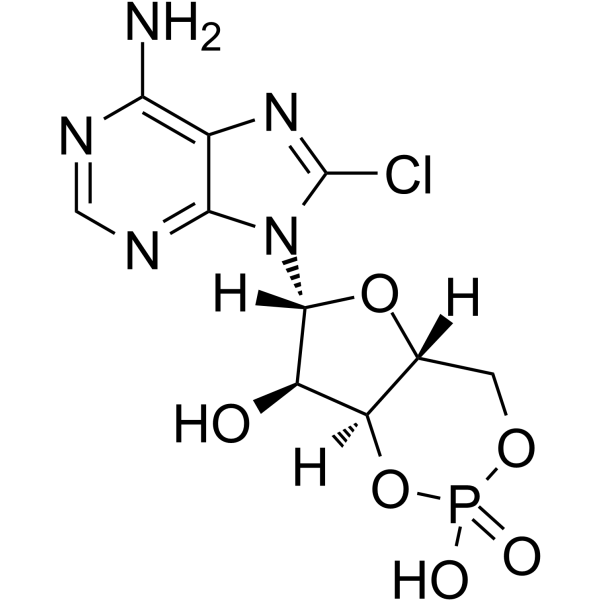8-Cl-cAMP

8-Cl-cAMP structure
|
Common Name | 8-Cl-cAMP | ||
|---|---|---|---|---|
| CAS Number | 41941-56-4 | Molecular Weight | 363.65100 | |
| Density | 2.55 g/cm3 | Boiling Point | 731.7ºC | |
| Molecular Formula | C10H11ClN5O6P | Melting Point | N/A | |
| MSDS | USA | Flash Point | 396.3ºC | |
|
Involvement of Akt2/protein kinase B β (PKBβ) in the 8-Cl-cAMP-induced cancer cell growth inhibition.
J. Cell Physiol. 228(4) , 890-902, (2013) 8-chloro-cyclic AMP (8-Cl-cAMP), which induces differentiation, growth inhibition, and apoptosis in various cancer cells, has been investigated as a putative anti-cancer drug. However, the exact mechanism of 8-Cl-cAMP functioning in cancer cells is not fully ... |
|
|
Glucagon stimulates ghrelin secretion through the activation of MAPK and EPAC and potentiates the effect of norepinephrine.
Endocrinology 154(2) , 666-74, (2013) Ghrelin is a stomach-derived orexigenic hormone whose levels in circulation are altered by energy availability. Like ghrelin, the glucotropic hormone glucagon increases in the fasting state and serves to normalize energy levels. We hypothesized that glucagon ... |
|
|
The cAMP analogs have potent anti-proliferative effects on medullary thyroid cancer cell lines.
Endocrine 51 , 101-12, (2016) The oncogenic activation of the rearranged during transfection (RET) proto-oncogene has a main role in the pathogenesis of medullary thyroid cancer (MTC). Several lines of evidence suggest that RET function could be influenced by cyclic AMP (cAMP)-dependent p... |
|
|
cGMP and cyclic nucleotide-gated channels participate in mouse sperm capacitation.
FEBS Lett. 586(2) , 149-53, (2012) During capacitation of mammalian sperm intracellular [Ca(2+)] and cyclic nucleotides increase, suggesting that CNG channels play a role in the physiology of sperm. Here we study the effect of capacitation, 8Br-cAMP (8-bromoadenosine 3',5'-cyclic monophosphate... |
|
|
Intracellular succinylation of 8-chloroadenosine and its effect on fumarate levels.
J. Biol. Chem. 285(11) , 8022-30, (2010) 8-Chloroadenosine (8-Cl-Ado) is a ribosyl nucleoside analog currently in phase I testing for the treatment of chronic lymphocytic leukemia (CLL). 8-Cl-Ado activity is dependent on adenosine kinase and requires intracellular accumulation of 8-Cl-Ado as mono-, ... |
|
|
The second subunit of the replication factor C complex (RFC40) and the regulatory subunit (RIalpha) of protein kinase A form a protein complex promoting cell survival.
Cell Cycle 4(2) , 323-9, (2005) Replication Factor C (RFC) is required for the loading of Proliferating Cell Nuclear Antigen (PCNA) onto DNA during DNA replication, repair and recombination. RFC40, the second subunit of the RFC complex, and PCNA have been shown to be overexpressed in gestat... |
|
|
8-Cl-cAMP and its metabolite, 8-Cl-adenosine induce growth inhibition in mouse fibroblast DT cells through the same pathways: protein kinase C activation and cyclin B down-regulation.
J. Cell Physiol. 201(2) , 277-85, (2004) 8-Chloro-cyclic AMP (8-Cl-cAMP) is known to be most effective in inducing growth inhibition and differentiation of a number of cancer cells. Also, its cellular metabolite, 8-Cl-adenosine was shown to induce growth inhibition in a variety of cell lines. Howeve... |
|
|
The combination of sulfinosine and 8-Cl-cAMP induces synergistic cell growth inhibition of the human neuroblastoma cell line in vitro.
Invest. New Drugs 24(1) , 15-25, (2006) To identify purine analogs that could be effective in treating neuroblastomas, we tested the anticancer properties of sulfinosine, 8-Cl-cAMP and 8-Cl-adenosine in the SK-N-SH cell line. First we examined the effects of these three agents on cell growth inhibi... |
|
|
Rap1 and p38 MAPK mediate 8-chloro-cAMP-induced growth inhibition in mouse fibroblast DT cells.
J. Cell Physiol. 209(3) , 1039-45, (2006) 8-Cl-cAMP, which is known to induce differentiation, growth inhibition, and apoptosis in various cancer cells, has been investigated as a putative anti-cancer drug. Previously, we reported that 8-Cl-cAMP and its metabolite 8-Cl-adenosine induce growth inhibit... |
|
|
8-Cl-adenosine inhibits proliferation and causes apoptosis in B-lymphocytes via protein kinase A-dependent and independent effects: implications for treatment of Carney complex-associated tumors.
J. Clin. Endocrinol. Metab. 94(10) , 4061-9, (2009) Carney complex, a multiple neoplasia syndrome, characterized primarily by spotty skin pigmentation and a variety of endocrine and other tumors, is caused by mutations in PRKAR1A, the gene that codes for the RIalpha subunit of protein kinase A (PKA). PKA contr... |